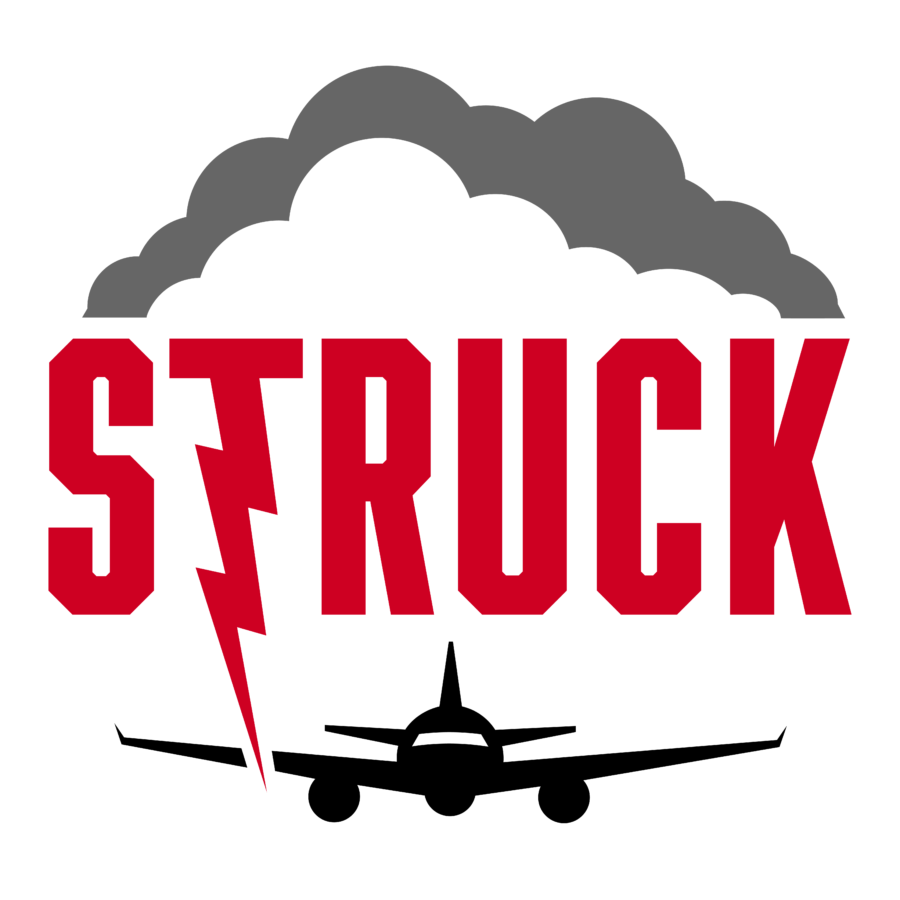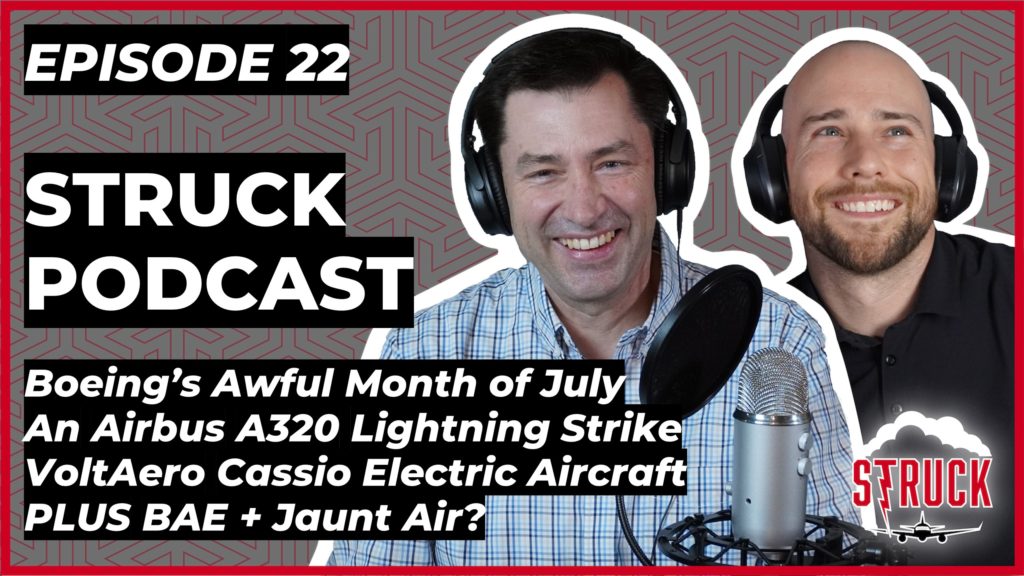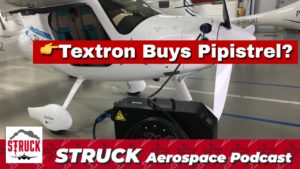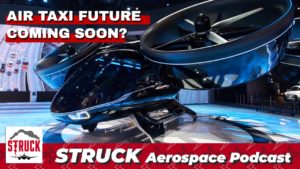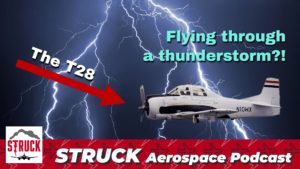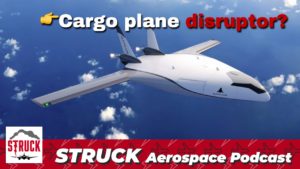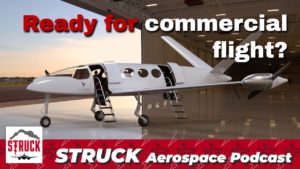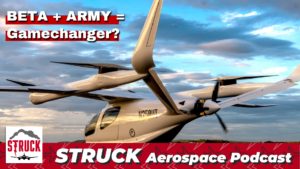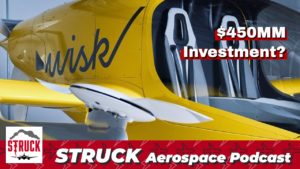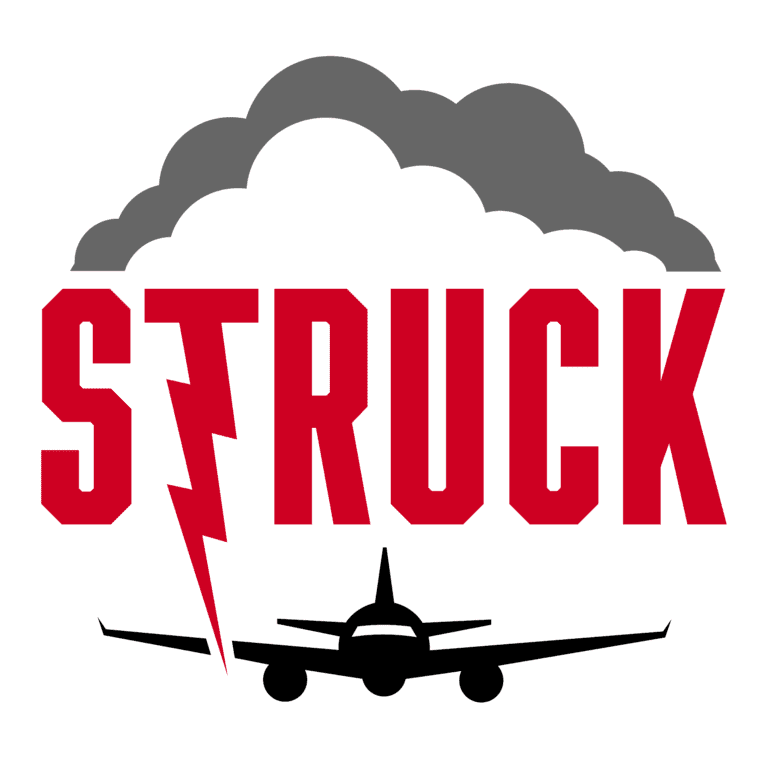In this episode we discuss BAE’s partnership with Jaunt Air Mobility, Boeing’s continued trouble delivering airplanes, a lightning strike to an Airbus A320 in New Zealand and more. We also take a look at the VoltAero Cassio, a unique medium-range hybrid electric aircraft prototype and discuss its road to airworthiness certification.
Learn more about Weather Guard StrikeTape segmented lightning diverter strips. Follow the show on YouTube, Twitter, Linkedin and visit us on the web. Have a question we can answer on the show? Email us!
Podcast: Play in new window | Download
Full Transcript: Struck Podcast EP22 – Boeing’s Tough Sales Month; An Airbus A320 Gets Struck By Lightning, BAE & Jaunt Air Partner on Flight Controls, Plus VoltAero’s Hybrid Electric, Aircraft, the Cassio
Dan: This episode is brought to you by Weather Guard Lightning Tech. At Weather Guard we support design engineers and make lightning protection easy.
You are listening to the Struck podcast. I’m Dan Blewett.
Allen: I’m Allen hall.
Dan: And here on Struck, we talk about everything aviation, aerospace engineering, and lightning protection.
Alright, I’ll come back to the Struck podcast. I’m your cohost Dan Blewett. And we’ve got a great show for you here today. And our first segment, we’re going to cover some kind of scary news, uh, on an Airbus, uh, out of New Zealand was diverted after a lightning strike. So we’ll, we’ll chat a little bit about that.
Um, Boeing seven 37 max might be delayed again. I mean, the saga continues, uh, we’ll chat a little bit more about Boeing and the, the amount of jets they delivered this quarter or not this quarter, but this past month, which was crazy low, um, and a little weird quarantine run in from, uh, unlucky a plane full of people.
So that’s a, some. Kind of funny, uh, COVID news here, but in our engineering segment, we’ll talk a little bit about, uh, BAE working with John’s, um, on flight control actuators, and then our EVT O L of the week. We’re going to talk about the connect air, uh, the volt Aero Casio, which is a four Cedar, um, actually maybe larger pass, uh, passenger capacity.
So pretty interesting little pusher, plane Allen, what is going on?
Allen: Well, it it’s really strange aircraft news over the last week or two. I know it, it seems like airlines are struggling and they are, uh, but I got to say that the aircraft industry in terms of projects has been relatively busy and that’s a good positive sign because it’s all those little projects that get rolling that turn into larger products later on.
So. I think so.
Dan: Well, you said you’ve gotten some new, some new projects recently, right?
Allen: Yeah. Several. Uh, and that always comes and sometimes it just comes just because everybody’s sort of back from vacation, August early August, people like to take off and then they come back and, you know, mid August, September and things start rolling again.
It’s just kind of like the shutdown around Christmas and January is always chaos. Mid January is so positive. Some positive things going on out there.
Dan: Well, that’s, that’s good. That’s good news for sure. Everyone wants to get back to work and you see good people get rehired and the industry get back to normal.
That’s for sure. So let’s on that note, let’s start first with Boeing and how many jets they’ve delivered. So in July, 2018, and this is an article from Barron’s. They deliver 39 jets, uh, this past July, they delivered four. So what do you think about these numbers? Obviously, this isn’t surprising anyone given how insane this year has been.
Again, my prediction is still, we still have four months to go to see if the crackin comes out of the deep sea. Um, just to cap off this crazy year. But, I mean, what is your sentiment about four planes being delivered?
Allen: Well, the, the issue really for Boeing is the seven 37 max. And because of COVID, there’s not a lot of international flights going on.
So your bigger triple sevens, uh, Are just not going to be in a big production since in terms of demand, they’re just not going to be there. So the smaller seventh of three sevens are going to be a workhorse internally to the U S and also in Europe and Asia and all over the place. And since they can’t deliver them, it doesn’t, it doesn’t help their bottom line.
So they got to get the aircraft certified in which it looks like it’s coming closer and closer, at least in the U S
Dan: but it says here that, uh, the return outside the U S has maybe been slowed. So what’s that about?
Allen: And in terms of just outside sales, that’s how the U S.
Dan: Well, it looks like the European union aviation safety agency is still waiting for more clarity.
Yeah. And key update.
Allen: I don’t know if that’s a, a, uh, policy position that they’re having disputes about or an interpretation about. Particular rules that are maybe slightly different in the ASA and in other parts of the world versus the United States. But it does seem like there’s always a little bit of dragging.
Uh, when the European Airbus certifies an airplane, FAA tents can drag its feet. It seems like it, it doesn’t seem like. Either side is try to help the other country or region. Uh, I don’t know. So I don’t know if it’s politics or real engineering concern when you get to these levels of international disputes and the seven 37 is reached clearly international dispute territory.
Sometimes the engineers don’t get to play so much as much as the politicians get to step into it
Dan: could be both. Yeah, well, that was a good point by you that you’re right. Like stick air travel is going to be the first thing to come back and it’s going to be really busy at some point. And you’re right.
Like Boeing has the plane and they have like the perfect plane for that, but they just continue to have problems. Like they’ve gotten man the solution, but it’s just not there. So hopefully the seven 37 max gets, gets into the hands of these companies that want to fly it in our radar. Put it to good work and get people back around.
Yeah.
Allen: And I, I thought the Airbus 82 20 was going to pick up on some sales and deliveries just because they are not necessarily a one to one competitor to the seven 37, but they are sort of that regional jet, new, modern out a cockpit designed cabin efficiency has all the checks, all the boxes. They two 20 does.
And it has seen some improved sales. There’s no doubt about that, but they’re not going to rival the seven 37 anytime soon. So people were still waiting for the seven 37 or they’re not taking airplanes one or the other.
Dan: Yeah, absolutely. So let’s talk about Airbus. So there was an air New Zealand that got struck by lightning and quickly diverted.
And this is really sad because it’s a beautiful plane. Like I’m looking at this photo and it’s like black with that. Cool. Like feather or a, maybe it’s a leaf, whatever it is at the end, kind of like little, some little tribal symbol on the, on the tail. Coolest plane like that. Plane’s awesome. But anyway, this is, I mean, planes get struck in commercial flight about once a year.
So why is this plane diverting? Like I thought it’s not a big deal where they just kind of keep going and no big deal, but that doesn’t seem to be the case.
Allen: It’s not a safety impact as much as it is an inspection requirement of trying to handle. And if you’re at a major hub where you have mechanics and.
And technicians to inspect the aircraft. You probably don’t want to fly away from the hub. You wanna go back to that hub? They were craft inspected so they can get back in services as soon as they can. If you fly to some remote destination and or if you’re going to fly with a water. So this is, is New Zealand.
So there’s a lot of flights. Most likely over water. I’m not sure you want to take a long flight over water and you’ll probably want to revert back. It’s like if you’re flying from London to New York and you had a lightning strike coming out of London, you’re probably going to go back to London. Um, similar, similar situation here, but there, there is, that does tend to play into the part of.
There’s mandatory inspections after lightening that have to occur. And if you go to a remote airport where you don’t have those mechanics technicians on site to do that inspection, then the airplane is essentially grounded. And then you’ve got to send a backup airplane to go, to get everybody to their next destination.
So sometimes it’s it’s as a passenger, it’s like the worst situation. The airplane turns around. It goes back and you’re stuck on the ground for a couple hours while they inspect the airplane. But. Overall, it’s probably your fastest way to get the flight completed.
Dan: Yeah. Well, in slightly more comical news Blaine was traveling from, from France to Oslo, Norway.
And landed just minutes after a mandatory quarantine was imposed. Meaning every passenger on board had to sell Valisa late for 10 days. I mean, obviously the coronavirus is no laughing matter, but that just seems like, Oh, we just met, we dismissed it. And then they’re stuck. And that really sucks. I mean, we’ve, you’ve talked about this before on how cumbersome that, I mean, how difficult that is for the industry in general.
Like if every time you travel, you have to quarantine. That’s a nightmare, but this one just seems like they, they just may, I got a bad draw here, but, um, but yeah, funny story next Atlanta and right
Allen: at midnight. And so the deadline was, or the quarantine period started at midnight. So if they had arrived at 1159, They would have been, I don’t know.
It sounded like the pilot was, cause it was all getting a little flustered there because he’s the impression was it was like, Hey, we landed in time. We landed at midnight. And the law says no at midnight it counts towards the quarantines. So should have fallen a little bit faster.
Dan: You gotta get, I feel like you had to get someone to fudge the paperwork for you at that point.
Like no, no one knows the pilot of favor. Like, come on. Just just rub it out. It was 1158 instead of 1201. Like no big deal. Yeah.
Allen: Oh
Dan: man.
Allen: Yeah. That we’re having that experience here in the States, too, where the quarantine thing is coming in. It’s a big deal to be quarantined for 14 days. Yes.
Dan: All right. So here in our engineering segment, we’re going to talk a little bit about BAE. Um, Alan. You’ve obviously had a lot of experience with all these different systems on, on aircraft. And you said one of the cool parts of your job is that you got to, you know, because you’re in high intensity radio-frequency and lightning protection that you were involved in lots more systems than perhaps other engineers, um, who are maybe, you know, put on just like wing projects or a little more niche parts of the aircraft.
So. Um, tell me a little bit about the, what would be a, he is doing with these fly-by-wire tests on, on .
Allen: So as, as you know, as they are, as we get to more electric aircraft and the aircraft, uh, get smaller. That means all the associated components are going to get smaller and lighter and more efficient. And, uh, companies like BAE who are making actuators and flight control computers and all kinds of avionics and electrical distribute, power distribution, stuff that they’re involved in all kinds of aspects on the aircraft.
Uh, they have a ton of expertise in, uh, a really long history, successful history. Of designing aircraft systems. So now that we’re having this sort of brand new marketplace with EVT, UL’s, BAE can just step right into that because they have the engineers to, to move that forward. Uh, and it’s not just like, I’m just going to go out and design an actuator, uh, one small actuator.
They’re thinking about the whole aircraft in terms of. How it integrates to one another, how they can save weight and cost over the whole vehicle, not just producing a particular component. And that’s where someone like BAE can have a lot of value added in interest aircraft corporation, because they can come to you with a whole suite of things that already talk to one another and already been qualified together.
So you’re not qualifying company with company B and trying to get the two to things to work together. They’re providing an integrated solution. That’s where, yeah, it’s a huge advantage. And if you can partner with someone like BAE, Early in your development, it just gets you to certification faster because the one thing that BAE definitely knows is how to certify systems.
So they’re going to really ramp your aircraft project towards a finish line way faster than without them. So it’s not just the, the, the advantages of having more efficient components. That’s totally true. But sometimes the worst. Part of aircraft design. Is this getting to certification on time? Because when you start slipping, you start spending millions and millions of dollars and you sometimes can’t recover from that.
Dan: And what is a fly by wire? So this is me being a layman, but what is a fly by wire system? Exactly mean?
Allen: It just means it’s electrically driven typically, or that the, the commands are by wires. If you think about a Cessna. Most people’s heads assess nine old Cessna, everything there is don’t act. The control surfaces are driven by, uh, wires control, wires, essentially cables, or, uh, to being of some sorts.
So it’s all mechanical, but, uh, in this particular case would be a, is offering is all electrical and faces much lighter.
Dan: Yeah. And so, I mean, we were, we were chatting before, um, we came on air here and. Just talking about like the payload capacity. So one of the, uh, the, the new EBTL Wells, the Volo copter, I remarked about how it’s got a max payload of 900 kilograms and it’s empty.
Weight is 700. I’m like man, 200 kilograms doesn’t seem like a lot. And that’s where you can definitely tell that shaving weight from something like this with, with BAE or any of these little weight savings could make a big difference. Cause I mean, you have two Husky dudes. That’s all mean they can’t have any luggage.
Right? I mean, Americans are fat. I mean, we’re a very fat nation. You have a 260 pound man or woman in there and you know, they’re traveling solo. So it seems like this is really important obviously for not only just a. You know, reducing potentially the amount of lift they need, or they can be a little quieter still, even though they’re way quieter than a than gastro oven, but also just making it easier.
Like you said, to get certified and get in the air. Right.
Allen: It’s all related to weight and cutting weight cost cuts, operational costs and allows more payload, which is a huge selling point for any aircraft. If you can get your golf clubs in it or kids kids’ backpacks or stuff, and then the aircraft, it just makes it much more fun.
Dan: All right. So our final segment here today, we always love talking about, uh, EVT. OL’s a new technology. And so today’s no exception. Let’s talk about the connect air. So, uh, they’re talking about, it’s a really cool design. Um, the Casio family of hybrid electric aircraft can carry between four and 10 passengers.
Um, and this is a pusher plane. So Alan, what what’s, what are the interesting features in this design? Cause it’s definitely futuristic looking for sure. Um, very sleek and smell. And why pusher instead of a front velour,
Allen: uh, usually it’s to make the cabin quieter. That’s why you put the propeller behind you a lot of times, if you can, it doesn’t make the, any more efficient that’s for sure.
Uh, we know that from the beach Starship days, because this aircraft has some resemblance, obese has a canard or any sort of Burt. Rutan is airplane of the era where it’s got a canard in the front and it’s got the. The propeller in the back. Uh, but the, the benefits of propeller in the back ends is quieter.
Uh, it sometimes can make a little more cabin space. Uh, you, you take the engines off of the wing. It has a lot of different benefits in terms of, uh, not so much aerodynamic performance as it is just sort of functionality that’s where it comes in.
Dan: And so volts, Aero who’s, uh, working with, uh, the on demand charter company connect air.
They claim they can get this certified under JASA CS 23 rules, um, by late 20, 22. Does that seem reasonable to you? I know you’re pretty passionate about certification. You’re very outspoken about certification. No. Why not?
Allen: Well, it’s a brand new design, so they’re going to get, uh, pushed through the. All the certification testing for materials, structure, uh, all the systems, all the qualifications for systems, those regulations are.
Are less than what they would be on a larger aircraft, but they’re still a huge amount of testing and money to be spent in engineering time to be spent to certify that aircraft. I’ve never seen a schedule aggressive as that. You can count on almost a five year start to finish, you know, or, or another clock you can put down typically is once they get to first flight, it’s about three years after first flight.
And in this particular case, uh, you have a feeling like this is sort of funding driven. So if you can get investors to buy into your shortened timeline, regardless of what promises you’re making them, it sort of feeds the machinery to keep them. The business up and running, you need that flux of cash and the positivity for the employees and everybody to keep paying everybody.
So it’s sort of a, it can turn into sort of a shell game because it’s, it’s extreme aircraft. Is it an extremely risky business, especially new aircraft, because you’re going up against known competitors. Like you’re going up against Honda, like really Honda has infinite compared to you, or you’re going up against an Airbus or are you going up against a text drawn or bell or somebody?
Those companies have been around forever and they have the resources to crush you. So anything that you do, uh, it’s gonna, if it has a positive. Influence on the market. Like if you’re changing things in the marketplace, don’t expect anybody else to on the, on their backside and watch you do it. They’re going to take those designs, incorporate into what they already have and beat you at your own game.
So it’s a very, very tough marketplace. And what they’re trying to do with saying, they’re going to certify by 2022, it says, basically says we’re going to beat our competitors to this design. Milestone, because we’re just faster, all the best. Right. All the best. I haven’t seen it really ever happened. So, you know, keep it with, you know, take that with a grain of salt.
Dan: Yeah. Well, in this and this design, I mean, it says, they’re hoping it can fly up to 800 miles at a speed of around 200 knots, which that’s pretty slow. So that’s going to take, take some time, but
Allen: yeah. Turbo. It’s basically turboprop speeds. Yeah. Well, it’s, it’s electric too.
Dan: Yeah. And if that gets you from, you know, say New York to Chicago, that’s going to be what, four, four or five hour flight instead of maybe a two hour flight.
It’s about a two hour flight from the East coast to Chicago.
Allen: Yeah. So it’d be about a four hour flight. And at those speeds. Yeah, roughly.
Dan: Yeah. And is this an, we haven’t seen too many in electric, uh, Sector here as we’ve been kind of reviewing these and going through them that’s that are really interested in this market or that’s a, that’s a pretty good distance.
Most of these, I mean, a lot of them in thinking about the Taino, go head over to Jim’s house, down the street and you’re your copter. And then others are like, well, let’s, maybe we’ll cut down like a three hour drive into a 45 minute flight. Right. And, um, Now, this one seems like it’s an even much more long distance.
I mean, does that seem reasonable that, you know, electric vehicles would be to do that in the near future? It seems like the technology isn’t there, but I don’t know.
Allen: It depends on where their application is. Uh, I heard a good discussion today dealing with every aircraft is not going to fit every potential marketplace for every particular demand.
So there are very, it’s a very niche market. There’s the segmentation and it can be very clear, uh, years ago. They’re the. The eclipse aircraft out of Albuquerque, New Mexico. Uh, that little, little twin engine jet had a lot of use down to Florida going from Southern Florida to Miami, up to Northern Florida, um, Jacksonville or someplace like that.
So, yeah. It, you know, it just from going across the state, it was a very useful aircraft and it had its own separate little marketplace there. California is going to be that way. Those parts of the U S and parts of Europe, the same way where there’s a marketplace, where a hundred miles, 200 miles is a pretty good sweet spot, uh, for making short, short flight, relatively short flights that are much faster than driving.
And so there’s a marketplace there. What, they’re not going to do it. It’s not going to fly in New York to Los Angeles in this thing that will not be their marketplace. So finding that market segmentation and finding that sweet spot will be key to success here.
Dan: Yeah. And just two more, little interesting things.
Number one, their propulsion system. Is a combination. So it’s an internal combustion engine that drives three 60 kilowatt electric motors. So they say that the quieter electric ones we use for takeoff and landing, and then the engine can extend extend range. How do you feel about it?
Allen: It’s a stepping stone.
I just think it’s a stepping stone. Um, No
Dan: efficiency. There’s just not, not quite there yet.
Allen: Right. And it’s so, and when, when it is there, they can switch it over. So if you can get, I had this discussion with a client yesterday about. Get the product out and get it in service, build your customer base and then get to the next generation because it’s more important to have something out in service and flying and productive than waiting for the ultimate in battery power to appear.
It’s that’s not likely to happen in the next six months. So it’s better, it’s better to be selling product then waiting to sell product feel.
Dan: Yeah. And they’re gonna allow users to book flights directly from a smartphone app from whatever airfield is nearest to them. So kind of again, going into that, like air taxi sort of feel.
But for a longer distance. So pretty interesting. I mean, as far as like, again, all the different electric vehicles, we’ve kind of talked about reviewed whatever you’d want to call it. This one’s definitely like a quirky different in between all the different ideas and different designs. And definitely it’s got its own seeming niche here.
Allen: The, the one key, the one key about all the electrics when we. Get to that point is that is going to offer, offer up new opportunities to fill different marketplaces. And you’re going to, I think what you’re going to see, and as I, we went to the air force, um, Museum in Dayton, Ohio last summer. And why through it?
And one of the, one of the key things that as you walk through that museum, cause it kind of goes from the Dawn of flight to today is the power plant changes everything. So aircraft design is based on the power plant and we are creating electric power plants. Now we’re in the early phases of that aircraft evolve with those power plants and.
We’re going to see new opportunities arise in the aircraft market to fill other places that we couldn’t satisfy before, because the power plant will let us do it. That’s where I think the opportunities lies, understanding where those new marketplaces are gonna pop out because the power is going to let us do it.
Dan: All right. Well, that’ll do it for today’s episode of Struck. If you’re new to the show. Thank you so much for listening. And please leave a review and subscribe on iTunes, Spotify, or wherever you listen to podcasts. Check out the Weather Guard Lightning Tech YouTube channel for video episodes, full interviews and short clips from the show and follow us on LinkedIn, Twitter, Instagram, and Facebook.
Our handle is @wglightning. Tune in next Tuesday for another great episode on aviation, aerospace engineering and lightning protection.
Strike tape, Weather Guard Lightning Tech’s proprietary lightning protection for radomes provides unmatched durability for years to come. If you need help with your radome lightening protection, reach out to us at weatherguardaero.com. That’s weatherguardaero.com.

